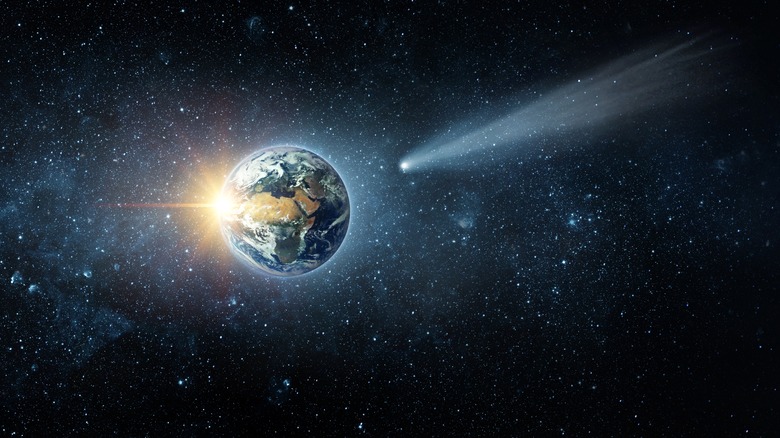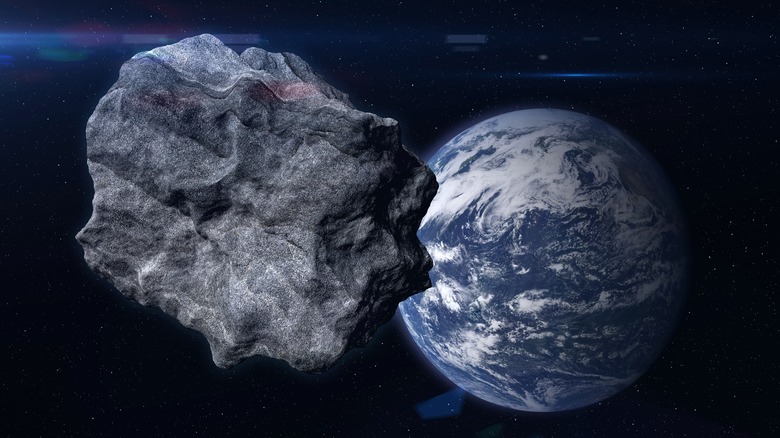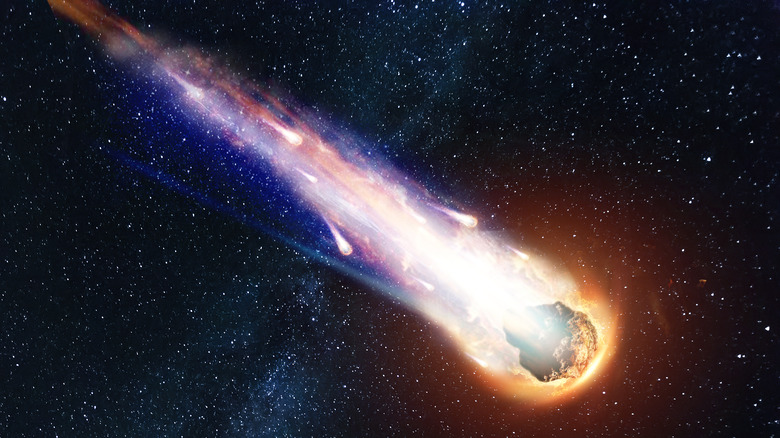What Is The Difference Between A Comet And A Meteor?
When it comes to space rocks, there are many different classifications astronomers use to differentiate between these objects. Planets, dwarf planets, moons, asteroids, comets, meteors, the list of astronomical objects goes on and on. While these classifications are useful for astronomers, they can be a bit troublesome for the rest of us. In particular, the difference between comets and meteors can be especially confusing, as these objects look very similar. Luckily, knowing the difference between them is easier than you might think.
According to Britannica, a comet is "a small body orbiting the sun with a substantial fraction of its composition made up of volatile ices." Comets typically have oval-shaped orbits called elliptical orbits that take them very far away and very close to the sun, according to Space. Many comets go well past the orbit of Pluto when they are at the farthest points of their orbits. When they get close to the sun, its heat causes the comet to begin to melt, sending a tail of dust and gases away from the sun (via NASA). A common misconception about comet tails is that they flow behind the comet. While this can be the case part of the time, a comet tail will always be pushed away from the sun by it's intense Solar Wind, meaning comet tails can ostensibly be in front of a comet after it has passed the Sun.
Asteroids are small objects in space that orbit the Sun
While a comet is a larger, mostly icy body orbiting the sun, asteroids tend to be smaller and also orbit the sun in an ellipsis. Asteroids are much smaller and the entirety of their mass would be less than that of the Earth's moon. They can have varying compositions, with different classifications for each. Some are made of clay, others are considered "stony," while others are comprised of mostly nickel and iron as NASA explains.
Asteroids can orbit the sun from any point, but tend to congregate in specific areas. There are two main areas astronomers have found large quantities of asteroids. The first is the asteroid belt between Mars and Jupiter, which happens to separate all the rocky planets Mercury, Venus, Earth, and Mars from the gas giants Jupiter, Saturn, Uranus, and Neptune (via Dictionary). Another place where there is a large congregation of asteroids is the Kuiper Belt, which is where Pluto and several of its other dwarf planet friends orbit, as NASA writes.
Meteors are space rocks that enter Earth's atmosphere
When a rock from space enters Earth's atmosphere, it is called a meteor. Any type of space rock can become a meteor, including pieces of comets and asteroids (via NASA Space Place). When a meteor enters the atmosphere, it begins to burn up as it rapidly falls to the surface. Most of the time, meteors are small and burn up while still in the atmosphere. If a meteor is large enough, part of it will make it through the atmosphere and crash down on the surface. When this happens, the remaining space rock is called a meteorite (via the National Informal Stem Education Network).
Sometimes a meteor will explode at the end of its journey through the Earth's atmosphere. When this happens, a fireball can be seen. Fireballs are meteors that are extremely bright. In order for a meteor to be considered a fireball, it needs to be as bright as Venus or brighter (via the American Meteor Society). Venus is the brightest object in the sky other than the sun and moon under normal conditions, but fireballs can be much brighter when they occur.


